SaaS Marketing Guide
6 SaaS inbound marketing tactics for MRR growth
Book a FREE SEO Strategy Consultation >
Further Reading:
- SaaS Marketing Strategy
- SaaS Content Marketing
- SaaS SEO
- SaaS Account Based Marketing
- SaaS Email Marketing
- SaaS Inbound Marketing
- SaaS Retargeting
- SaaS Marketing Budget
- SaaS Marketing Plan
- SaaS Referral Marketing
- SaaS Demand Generation
- SaaS Customer Journey
- SaaS CMO Strategy
- SaaS link building
- SaaS Lead Generation
- SaaS Landing Page Examples
- SaaS CMS
- SaaS Customer Churn
- SaaS Marketing Automation
- SaaS Marketing Campaigns
- SaaS Marketing Agency
- SaaS SEO Agency
- SaaS Link Building Services
As you know, the SaaS industry is highly competitive. Customers are reluctant to invest in a product until they’re certain it fulfills their needs. This makes SaaS inbound marketing an essential component of your sales strategy.
Inbound marketing for SaaS attracts prospects to your business and establishes you as a thought leader in your niche. The aim is to build consumer confidence and trust so that when they’re ready to buy, they’ll turn to you.
Done well, SaaS inbound marketing can skyrocket your MRR (Monthly Recurring Revenue) growth. But, for that, you need high-quality content that’s tailored to your marketing funnel一and the strategies to make it work. That’s where we come in.
What exactly is inbound marketing?
Outbound marketing “pushes” your product to customers, for instance, through paid advertising.
In contrast, inbound marketing “pulls” customers toward your product with useful, engaging content. Inbound marketing yields better long-term results as it focuses on giving value to potential customers.
When potential customers get value from your content, it encourages them to return. Over time, this creates trust and familiarizes them with your brand. Then, when they’re ready to buy, they’re more likely to turn to you一especially if your content speaks to their pain points.
Trust-building is particularly important for marketing SaaS companies. This is because they tend to have a longer sales cycle than most other companies.
B2B buyers of SaaS solutions want to be sure they’re investing in the right tool, so they’re looking for content that will help them make an informed purchase. It’s crucial, then, to include inbound marketing as you build your SaaS marketing budget.
One final point is that inbound marketing for SaaS companies doesn’t stop at conversions. It also includes customer retention, upselling and cross-selling, and gathering data to improve the customer experience.
The SaaS marketing funnel
The SaaS marketing funnel differs from the B2C funnel as it includes an extra step: Retention. So, marketing for SaaS is about connecting with potential and existing customers.
By understanding the SaaS marketing funnel, you can create content to attract and retain customers at each stage of the buying journey.
Pro tip: A SaaS marketing agency can help you do this by creating useful, evergreen content that fulfills your audience’s needs. For instance, accelerate agency offers content creation, blog management, SEO optimization, and link building for your onsite and offsite content一helping you keep customers long-term.
Below are the five stages of the SaaS marketing funnel and the key metrics to track at each stage:
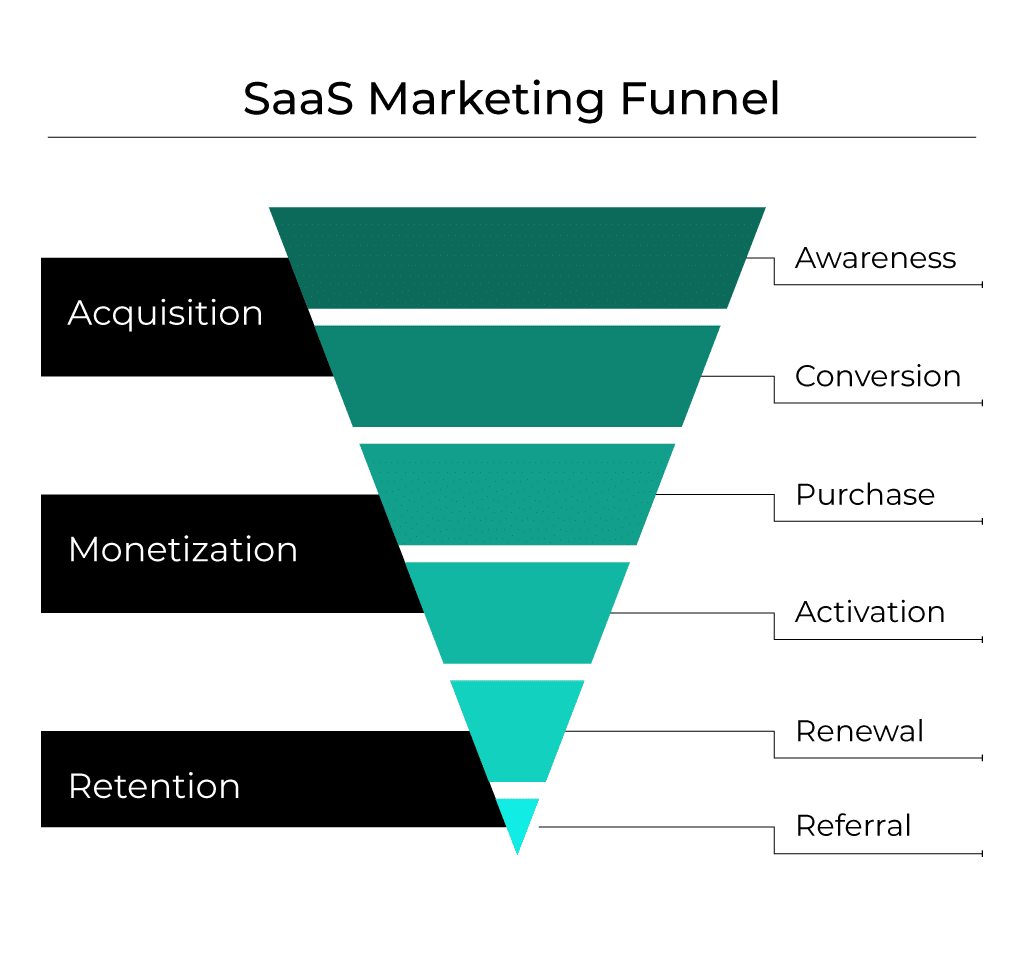
Awareness
At this stage, your potential customers are looking for information. They may not yet know about your company or product. Your content here should answer their questions and prove you’re a trustworthy source of information.
The first customer touchpoint is usually a search engine results page or social media post. So, focus on creating useful content that’s SEO-optimized. You could also invest in some inbound marketing techniques like paid search or social media ads.
Key metrics:
- Number of website visitors
- Bounce rate
- Click-through rate (CTR)
- Search engine ranking
- Digital impressions
Engagement
When potential customers sign up to receive extra material, like emails, they move to the “Engagement” stage. Now is the time to start introducing your product as a solution to their pain points. Value to the reader is still paramount, though, as people at this stage aren’t yet ready to buy.
Content for this stage should include a CTA, like a link to a how-to guide that expands on the topic of the post.
This is a great opportunity to get some details about your prospect, such as asking for their email address to download the guide.
Key metrics:
- Website metrics (such as time on page, number of views, and clicks)
- Email signups
- Newsletter subscriptions
- Digital engagement
Desire
Once prospects reach this stage, you’ve established a relationship with them and introduced them to your product. Now, your content should highlight the benefits of your product and how it can solve their problem.
Case studies, testimonials, comparisons, and reviews are particularly effective at this stage as they reassure potential customers that your product can help them. You could also offer a free trial or “freemium” version of your product so people can test it out first.
Key metrics:
- Free trial downloads
- Free trial activations
- Email open rate
- Demo requests
- Marketing qualified leads (MQL)
Conversion
This stage happens when a customer completes a milestone, like moving to a paid version of your product. Questions to ask at this stage include:
- What is your conversion rate?
- Is your churn rate decreasing (or increasing)?
- What types of content do people view/download/engage with the most?
This will help you determine if you need to change your funnel or content to get more people to convert.
Also, encourage customers to give feedback so you can learn what brought them to this funnel stage, what improvements you could make, and so on.
Key metrics:
- Conversion rate
- Customer acquisition cost (CAC)
- Average contract value (ACV)
- Churn rate
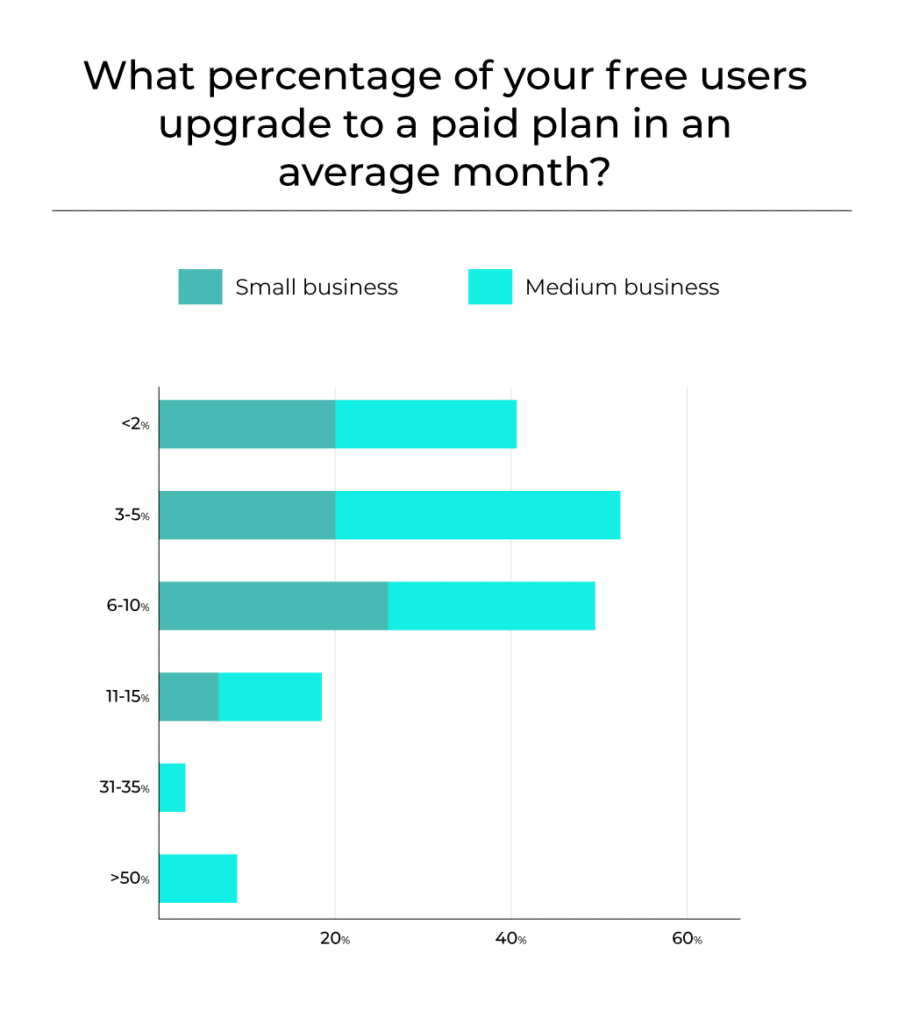
Retention
When marketing SaaS products, this stage is the most important. SaaS businesses rely on recurring revenue, so the content here is about building long-term loyalty.
This is also a great opportunity for upselling and cross-selling. For instance, you could offer discounts to long-term customers or send information about a related product.
Also, reward customers who refer your product to others, for instance with exclusive content or discounts.
Key metrics:
- Customer lifetime value (CLV)
- Customer retention rate
- Net promoter score (NPS)
- Customer satisfaction
- Product upgrades
- Churn rate
Channels and resources: Some examples of inbound marketing for SaaS
SaaS inbound marketing encompasses a lot of different channels and content types. Below are five examples of content that works well for SaaS companies.
Pro tip: The best SaaS marketing strategy uses a mixture of inbound marketing tactics to attract, engage, and convert prospects, as well as other tactics like outbound marketing and referral marketing.
Blogs
A blog is the cornerstone of inbound marketing for a SaaS company. It’s the perfect way to educate prospects on topics that matter to them and bring traffic to your website.
Here are some tips on how to blog successfully:
- Include a CTA, such as an email subscription form
- Update your blog regularly to stay relevant
- Write long-form content (1,500+ words)
- Use facts and figures to back up your claims
Infographics
An infographic gives readers a snapshot of useful insights, while graphs and other visuals make it appealing. You can publish an infographic on its own, or include it as part of a blog post.
Infographics are extremely engaging and shareable, which increases your reach.
Whitepapers
A whitepaper is an in-depth, educational piece of content. The people who download them expect actionable insights and data.
One advantage of whitepapers一and eBooks, too (more on those next)一is that you can request contact information to download them. You can then send emails to encourage leads further down your marketing funnel.
eBooks
An eBook is your chance to deep dive into a topic and establish your brand as an authority in the SaaS industry.
If you’re going to write an eBook, make sure it’s a topic with plenty to talk about. B2B eBooks should be around 5,000 words, if not longer. Also, include plenty of graphics to break up the text.
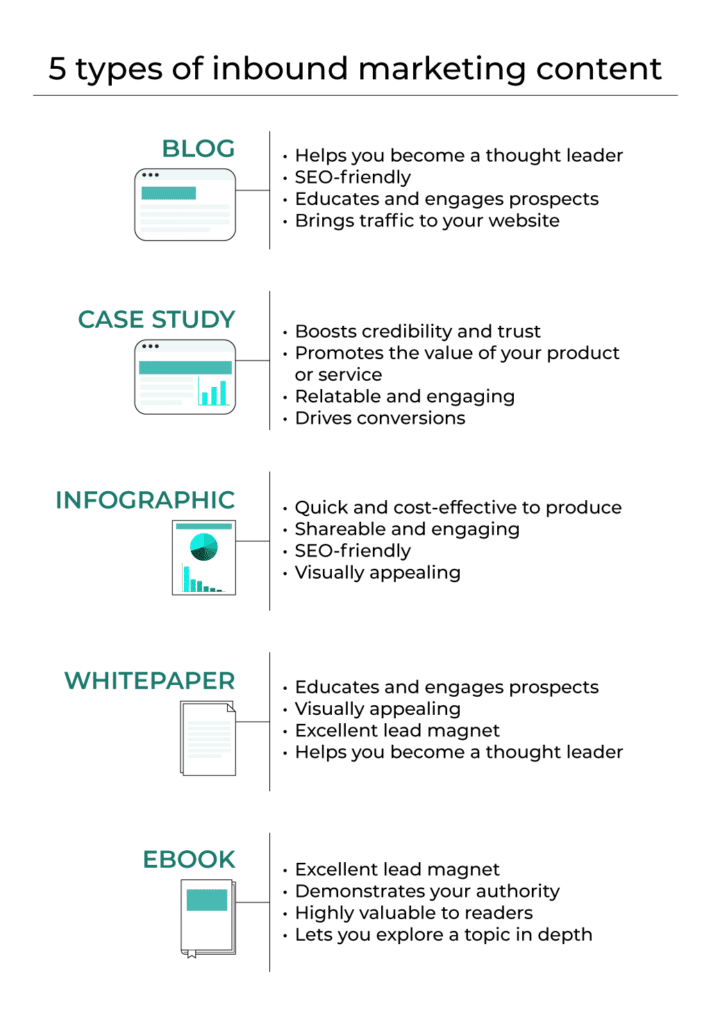
Case studies
A case study is a detailed look at how your product helped a customer achieve their goals. They’re an excellent way to reassure potential customers and encourage them to buy your product.
If you’re going to write a case study about a company, you’ll need their permission. To sweeten the deal, be sure to highlight how it could benefit them, such as giving them greater exposure.
Effective inbound marketing strategies for SaaS companies
Next, we’ll explore six effective SaaS inbound marketing strategies to retain customers long-term. These are:
- Understand your buyer
- Create a user-friendly site
- Remember that content (SEO) is king
- Get active on social media
- Optimize email marketing
- Utilize the power of automation
1. Understand your buyer
As with all marketing strategies, inbound marketing starts with understanding your buyer, including:
- Who they are (job title, company, and so on)
- What problems they’re trying to solve
- What their buying journey looks like
A good approach here is to create a buyer persona (that is, a profile of your ideal customer).
To create your persona, look at the company websites, social media profiles, and so on of your target audience. You could also conduct interviews and send surveys to your existing customers.
Once you understand your buyer, you can refine your marketing tactics and create content that speaks to the people you’re trying to reach.
Pro tip: You can use a tool like HubSpot’s Make My Persona to generate a buyer persona template for free.
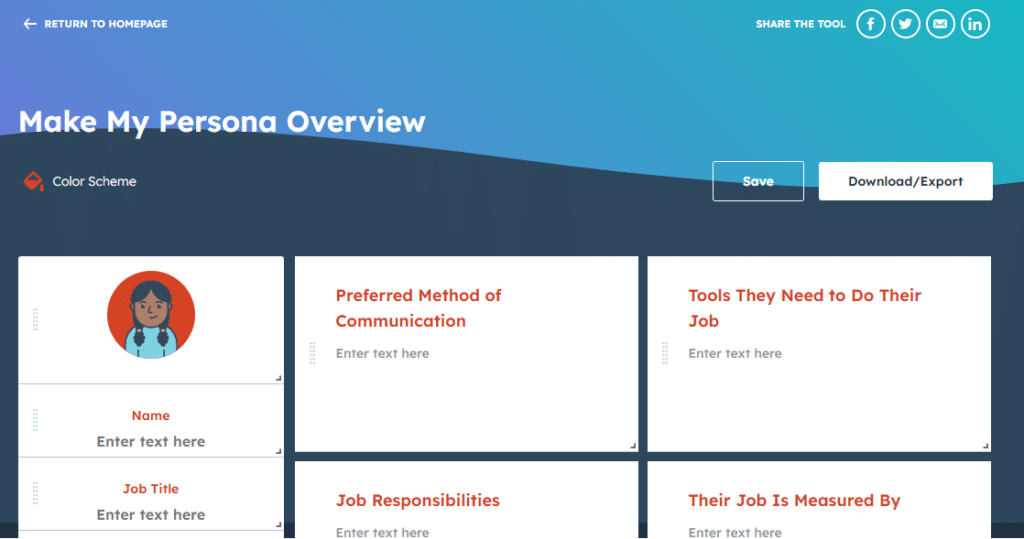
2. Create a user-friendly site
Your website is one of the key pillars of inbound marketing. It needs to be informative, user-friendly, and SEO-optimized.
Here are some tips on how to improve your site:
- Create and optimize landing pages. Landing pages are a great opportunity to speak to prospects’ pain points. You can also encourage them to learn more with well-placed CTAs. So, make sure they’re SEO-friendly and useful.
- Optimize page loading times. Slow loading harms the user experience, so check your loading time with a tool like PageSpeed Insights. Then, follow the suggestions to improve it.
- Make your site visually appealing. To attract visitors, your website needs to look good. Use a color palette that reflects your brand, and use graphics and videos (as long as they don’t compromise load time).
- Ensure your site is mobile-friendly. According to Statista, there are an estimated 6.9 billion smartphone users worldwide. So, it’s essential your website works well on mobile. Use a responsive design and check your site with Google’s Mobile-Friendly Test.
- Make your site easy to navigate. If your site is difficult to navigate, potential customers will leave. Make sure your menus and page headings are clear and simplify your internal linking structure.
3. Remember that content is king
SaaS content takes many forms, from videos and podcasts to blogs and whitepapers. Each piece of content should be valuable to readers and encourage them further down your marketing funnel.
You should also optimize content for search engines, as they’re a significant traffic source for SaaS companies.
A SaaS SEO consulting agency can do the hard work for you by creating helpful, SEO-optimized content for your onsite and offsite channels.
For instance, accelerate agency uses keyword gap analysis and competitor research to identify new content opportunities. We also optimize your onsite content and help you secure links from high-authority websites.
In addition, we offer ongoing reporting that keeps your content up-to-date with the latest industry trends.
Book a consultation and see how we could accelerate your content strategy.
4. Get active on social media
Once you’ve created and optimized your content, it’s time to promote it. Social media is a great place to start. According to HubSpot, social media was the top marketing channel in 2022:
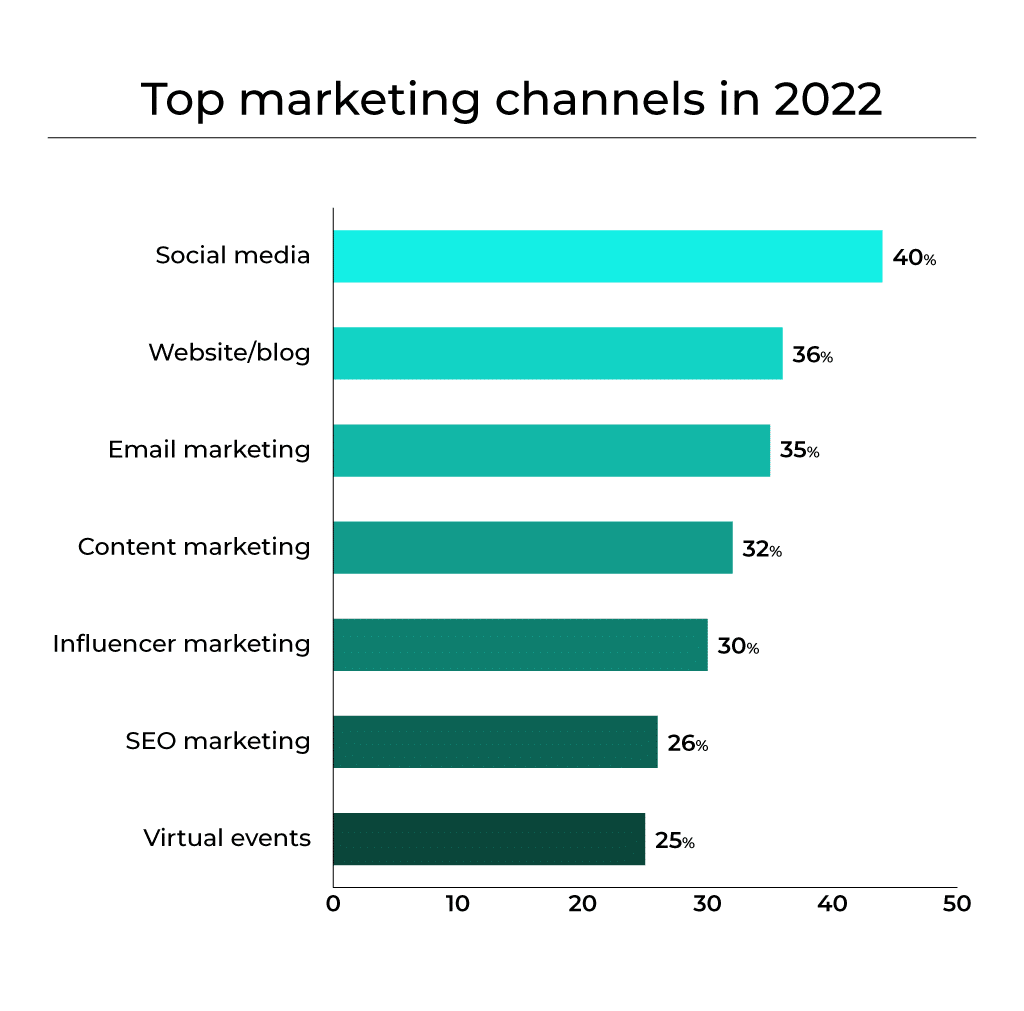
A strong social media presence builds brand awareness and connects you directly to customers. Social media content is also a great way to boost engagement.
Research which social media channels are popular with your buyer personas. Then, create engaging content that establishes you as a thought leader in your niche. You can also post fun quizzes and surveys to learn about your audience.
Finally, be sure to track social media KPIs like reach, engagement, follower count, and clicks.
5. Optimize email marketing
Once you have a prospect’s email address, you can send them content that educates them and gets them closer to converting. You can also send out surveys to gather feedback to improve the customer experience.
To optimize email marketing, you should:
- Write a compelling subject line. This is your (only!) chance to capture your reader’s attention and encourage them to open the email. Keep it short, punchy, and informative.
- Don’t spam your reader. Stick to weekly offers and newsletters, or you could overwhelm your reader and end up in the “Spam” folder.
- Personalize your emails. Use your customer’s name, and tailor your emails to their specific pain points and needs. This makes them more valuable.
- Test, test, test! Test different email formats and sending frequencies. Track your metrics (open rate, click-through rate, and so on) to see what works best.
6. Utilize the power of automation
Our final inbound SaaS marketing strategy is to utilize automation. For example, you can send automated emails in response to customer actions (like signing up to your mailing list) or at preset times.
Automation saves time and leaves your marketing team free to focus on improving the customer experience. It also makes scaling a breeze.
There’s a range of marketing automation tools to choose from. Consider your needs, research the different options, and choose a platform that suits you.
Leverage your MMR with the right SaaS inbound marketing strategy
SaaS inbound marketing is essential for companies to retain customers long-term. By following the strategies we discussed, you can pull prospects into your marketing funnel and convert them into loyal customers一boosting your MRR.
The best strategies aren’t static, though. As the market changes and your company grows, your inbound marketing strategy should change, too. Track your key metrics, and get regular customer feedback to optimize your approach.
You could also consider working with a SaaS agency like accelerate agency. We’ll help you identify areas for improvement and create high-quality, SEO-friendly content for each stage of the marketing funnel.
We’ll also do a deep dive into your website and optimize it with technical and onsite SEO.
Want to know more? Book a consultation and see how accelerate agency could help you leverage your MRR with inbound marketing and SEO.